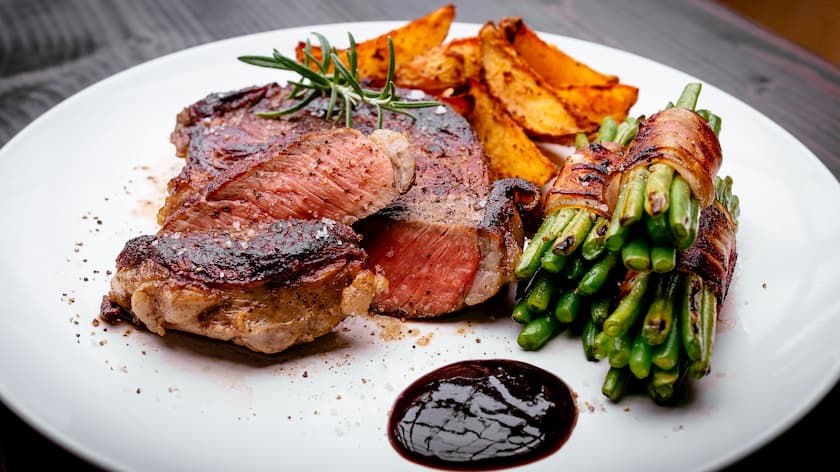Ask most anyone at the gym what their goal is and it’s likely along the lines of being leaner, stronger, and more muscular.
There are very few scenarios where a gym-goers lone goal should be to lose or gain weight just for the sake of seeing a quantitative change on the scale. Therefore, body-weight is not a sufficient measurement of progress by itself.
In the fitness and bodybuilding sense, body composition is the percentage of fat tissue that accounts for one’s overall body mass (hence the terms “body composition” and “body fat” are somewhat interchangeable).
One could also measure the amount of bone mass, water, muscle tissue, etc. that make up their body’s composition, but that is often impractical and very expensive.
The conundrum everyone faces is that improving body composition is a give and take process. The path to a leaner body is a difficult one, and the finish line doesn’t come overnight.
For decades fitness enthusiasts have dabbled over the idea of concurrently losing fat and building muscle often referred to as body recomposing. Burning fat and building muscle requires mutually exclusive energy intakes (you can’t ingest a surplus of calories and be in an energetic deficit and vice versa).
However, this doesn’t mean you can’t improve your body composition at any given time.
This is why the traditional approach for many trainees is to alternate between periods of building shedding fat and building muscle; these episodes are known as “cutting” and “bulking” respectively.
One way to think of the overall process is like it’s a see-saw: if you want to increase one then the other will have to decrease. The alternative is to be in a maintaining phase, in which you neither build muscle nor lose fat).
Therefore the routes necessary for improving body composition are quite clear; we either want to optimize muscle hypertrophy (while limiting fat gain) or optimize fat burning (while limiting muscle loss).
Given this, the rest of this article will take a look at how metabolic expansion can help set yourself up for success in improving your body composition, and allow you to eat more while doing it.
Expanding Your Metabolism
Metabolism is a term that most everyone is familiar with but few actually understand, so this section will serve to give you an overview of what exactly metabolism is and what it means to expand or increase it.
All living organisms are made up of the simplest living unit: the cell. Even simple single-cell microbes are “alive. ” That being said, humans are much more complex and composed of an astronomical amount of cells (100s of trillions).
Given this, metabolism is essentially the summation of all chemical reactions within the cell that are necessary to sustain life.
These reactions are divided into two classes that many readers are likely familiar with: anabolic and catabolic. The former uses energy to build cellular components and molecules, while the latter gives off energy as they break down complex substrates.
A basic example is the breakdown of glucose to form ATP (the energy currency of the cell) and pyruvate (which enters the Krebs Cycle).
Many variables such as physical stress, nutrient availability, hormonal signaling, and energy status affect how these reactions occur and when they take place.
The main prerequisite when it comes to improving one’s body composition is to elevate metabolic rate as much as possible. You want to first expand your metabolism so you have room to work with and reduce calorie intake when it comes time to shed fat.
One concept that eludes people is that one should aim to be more metabolically inefficient instead of efficient.
A good way to think of this is viewing your metabolism as a vehicle and food as your fuel source; you want a less efficient vehicle as it will need more gas to travel the same distance as a more efficient vehicle.
So if you want to eat more and maximize the amount of gas you need, you better decrease your metabolic efficiency (or start shopping for a Hummer).
There are several factors that help expand your metabolism, but the main one to focus on is building skeletal muscle tissue (since muscle is more metabolically demanding than adipose tissue). Back to that metaphor, a V8 muscle car (no pun intended) needs more fuel to travel just as far as a 2-cylinder sedan.
Ultimately, the less efficient your metabolism is, the more you can eat throughout the process of improving body composition. Intuitively then, you want to increase your metabolic capacity early on.
Long-term energy restriction will gradually decrease metabolic rate, and you will eventually reach a plateau where fat loss just won’t budge anymore and you will put on fat quickly when trying to build muscle. Obviously, that makes the journey to a lean physique a daunting one.
Therefore, it is crucial to get your metabolism “revving” (so to speak) before you try shedding off extra flab. This is not to say you absolutely can’t lose fat without first working on building muscle mass, but just that it benefits you in the long run and makes the process of improving your body composition much less stressful and sustainable.
Remember that muscle is more metabolically demanding than adipose tissue, so by building more muscle, you are “expanding” your metabolism and making it more inefficient.
This is the reason that many bodybuilders can stay in such good shape with little to no cardio in their regimen since they’ve developed such an inefficient metabolism that it becomes rather hard to “out eat” their calorie expenditure. Pretty good “problem” isn’t it?
Maximizing Muscle Anabolism
Recall that reactions that build molecules are anabolic; intuitively then you’ve likely guessed that building skeletal muscle tissue requires a state of cell anabolism.
At its simplest form, muscle hypertrophy and anabolism occur when the net protein turnover ratio is in favor of muscle protein synthesis (MPS) over muscle protein breakdown/degradation (MPB).
Contrarily, a net protein turnover ratio that favors MPB over MPS is indicative of muscle catabolism. A medley of variables causes the protein turnover ratio to fluctuate, such as gene expression, endocrine factors, pharmaceutical agents (e.g. PEDs), over-the-counter supplements, disease/immune conditions, nutrition, exercise, etc.
Therefore, in an ideal world where muscle growth is the goal, we want to maintain maximize the rate of MPS and minimize the MPB. Piece of cake, right?
Well before you start guzzling down the nearest protein shake, consider that MPS is frugally regulated by a protein encoded in the FRAP1 gene in humans named the mammalian target of rapamycin (mTOR).
(1) The mTOR protein itself acts as the backbone to mTOR protein complexes, such as mTORC1 and mTORC2. When the requisite cellular conditions are met, mTOR protein complexes activate MPS and induce cell growth and proliferation.
(2) The necessary cell conditions for MPS to proceed are influenced by several factors, including the cell’s energetic state, circulating growth factors and hormones (insulin, androgens, growth hormone), nutrient availability, oxidative stress, and others.
As noted earlier, regulation of MPS pathways is highly regulated and complex (and extends beyond the premise of this article), but it’s still useful to have this basic knowledge of mTOR and how muscle cells actually grow.
Naturally then, to maximize/optimize muscle building, the aim is to augment the aforementioned cellular factors to up-regulate MPS. This is where things like proper nutrition, exercise, and supplementation come into play.
Much to my chagrin, those are all topics of much debate and worth their own article. Moreover, everyone is unique to a degree and will need some trial and error to figure out how to optimize the muscle-building process.
“Turning On” Fat Loss
On the fat loss side of things, the mechanisms conducive to increasing fat burning are more or less directly antagonistic to those mechanisms involved in muscle building (and vice versa).
Fat loss is largely (but not entirely) regulated by the enzyme adenosine monophosphate-activated protein kinase (AMPk), a trimeric protein expressed throughout many tissues in the body.
AMPk increases lipolysis, enhances fatty acid oxidation, improves glucose uptake into muscle tissue, and inhibits lipogenesis. (3, 4) Basically, it is the “master switch” for burning fat.
Adenosine triphosphate (ATP), the energy currency of the cell, breaks down to form adenosine diphosphate (ADP) and free energy; AMPk is activated when the cell is in a state of energy deprivation (i.e. the ATP: ADP ratio drops).
This occurs during times of nutrient (specifically glucose) deprivation, exercising, ischemia (lack of blood supply to an organ), and /or use of certain chemicals/drugs. Conversely, things such as eating and excessive glycogen levels inhibit AMPk activity (since the ATP: ADP ratio is elevated).
Why does this all matter in the grand scheme of improving body composition? Well frankly, while AMPk is great for “turning on” fat burning, it is also an inhibitor of mTOR (and thus, muscle protein synthesis). (8) Conversely, mTOR reciprocates by inhibiting AMPk, so when MPS is activated fat burning is inhibited.
The good news, however, is that this doesn’t mean it’s impossible to build muscle and burn fat over a short (or long) time span, just that the progress will be slower and require diligent effort and consistency as far as diet and training go.
Nevertheless, it is safe to say that if you want to build an appreciable amount of muscle and burn fat, it’s in your best interest to heed the following advice:
Protein is crucial—Research seems to suggest that as long as the protein source(s) you ingest contain the necessary leucine content (and other essential amino acids) then there is little difference in MPS between sources (e.g. milk, animal protein, egg protein, etc).
[5, 6]
Generally, 30+ grams of a leucine-rich protein source will provide a sufficient elevation in muscle protein synthesis for a solid 3-4 hours post ingestion. That being said, protein needs will vary for everyone based on their training regimen, age and body composition.
Fats are essential, literally—Fatty acids have a variety of roles in sustaining cellular integrity/functions. Unsaturated fat sources, especially the omega-3 fatty acids docosahexaenoic acid and eicosapentaenoic acid are revered for their cardiometabolic health benefits.
Also, saturated fatty acids are necessary for proper hormone production (mainly androgens). Contrarily, an excess amount of saturated fat intake is associated with insulin resistance and metabolic maladaptations, so don’t go overboard.
[5]
As a baseline, start with about 25% of your total fat intake coming from saturated fats and emphasize unsaturated fats for the rest.
Carbohydrates are anabolic augmenters— Gym-goers often seem to have a love-hate attitude toward carbohydrates due to their inherent insulinogenic property (save for fructose).
Lest they forget that some amino acids are also insulinogenic, and more importantly, that insulin is a potent anabolic hormone. Therefore if you want to pack on some solid muscle tissue, it is quite conducive to manipulate insulin secretion in your favor.
Numerous studies have verified that the muscle protein synthesis response to a nominal dose of amino acids can be enhanced by the presence of an increased insulin response.
Moreover, carbohydrates refill liver and muscle glycogen stores. The protein-sparing effect of carbohydrates is crucial to muscle building since fewer amino acids will be utilized for energetic purposes when sufficient glycogen and/or glucose is available.
Maximize Peri-workout Nutrition —Intense training elicits a myriad of acute metabolic effects, such as upregulation of glucose transport proteins and enhanced blood flow in muscle tissue.
It behooves you to take advantage of these favorable metabolic adaptations via proper nutrient intake around the training time frame, generally by eating a generous amount of carbohydrates and protein.
This isn’t to say you shouldn’t take in any fat at this time either, but just not a superfluous amount as fat can slow digestion and blunt insulin secretion.
Emphasize compound/multi-joint exercises and progression in the gym–When you go into the gym one of your main priorities should be progressing from your previous workout, especially on multi-joint exercises like presses, rows, squats, and deadlifts.
It’s astounding how many trainees nonchalantly lift the same weight for months, even years, on end and (not surprisingly) they look the exact same now as they did on day one.
Bear in mind that progression comes in many forms, such as adding weight to the bar, longer time under tension, varying rep cadence, increasing reptitions, adding various intensity techniques like drop-sets, etc. Just focus on progressing/improving in some capacity each week.
Cardio considerations–Cardiovascular exercise, specifically high-intensity interval training (HIIT) appears to provide many of the same benefits associated with resistance training. [8]
Thus, it wise to incorporate both resistance training and cardiovascular exercise (preferably HIIT) into your regimen.
However, do not overdo cardio, especially at lower intensities as this can actually hamper your metabolism in the long run. This doesn’t mean you should never do low-intensity cardio, but frankly, if your goal is to build muscle and increase your metabolic capacity, then it’s safe to say your focus should be on intense weight training.
Don’t neglect rest–Time in the gym is certainly important in order to provide stimulation for muscle growth, but you should not be living in the gym either. You grow during the hours spent out of the gym (especially during sleep), and skipping out on rest and recovery is sure to hinder your rate of progress.
Moreover, even acute losses of sleep can lower insulin sensitivity and increase your food cravings, so don’t make it a habit to lose sleep. Keep a sound sleeping regimen, and try to get between 6-8 hours per night. If you can, also consider taking a power nap or two throughout the day when time permits.
Again, when you’re in the gym, work hard, but when it’s time to go home, go home. More isn’t always better, especially when it comes to time spent in the gym. Lift, eat, sleep, and repeat (what a tough lifestyle, eh?)
These may not be profound tips, but I tend to hold onto the K.I.S.S. (Keep it simple, stupid) principle. Many gym-goers make the muscle-building and fat-loss processes out to be much harder than they really are.
Bringing it All Together
Hopefully, this article has taught you a bit more about the physiology behind building muscle and burning fat.
The tips supplied herein a somewhat broad, but don’t worry JackedFactory has you covered with this Building Muscle & Burning Fat Brochure.
No more guessing, this FREE eBrochure will give you specific recommendations for your diet and training!
References:
1. Tokunaga C, Yoshino K, Yonezawa K (2004). “mTOR integrates amino acid- and energy-sensing pathways”. Biochem Biophys Res Commun 313 (2): 443–6. doi:10.1016/j.bbrc.2003.07.019. PMID 14684182.
2. Wullschleger S, Loewith R, Hall MN (February 2006). “TOR signaling in growth and metabolism”. Cell 124 (3): 471–84. doi:10.1016/j.cell.2006.01.016. PMID 16469695.
3. Ruderman NB et. al. Minireview: Malonyl CoA, AMP-activated protein kinase, and adiposity. Endocrinology (2003) 144: 5166-5171.
4. Bolster, DR. AMP-activated protein kinase suppresses protein synthesis in rat skeletal muscle through down-regulated mammalian target of rapamyacin (mTOR) signaling. J Biol Chem (2002) 277: 23977-23980.
5. Katsanos CS, Kobayashi H, Sheffield-Moore M, Aarsland A, Wolfe RR. A high proportion of leucine is required for optimal stimulation of the rate of muscle protein synthesis by essential amino acids in the elderly. Am J Physiol Endocrinol Metab. 2006 Aug;291(2):E381-7. Epub 2006 Feb 28. PubMed PMID: 16507602.
6. Paddon-Jones D, Sheffield-Moore M, Katsanos CS, Zhang XJ, Wolfe RR. Differential stimulation of muscle protein synthesis in elderly humans following isocaloric ingestion of amino acids or whey protein. Exp Gerontol. 2006 Feb;41(2):215-9. Epub 2005 Nov 23. PubMed PMID: 16310330.
7. Kraegen, E. W., Clark, P. W., Jenkins, A. B., Daley, E. A., Chisholm, D. J., & Storlien, L. H. (1991). Development of muscle insulin resistance after liver insulin resistance in high-fat–fed rats. Diabetes, 40(11), 1397-1403.
8. Mendes, R., Sousa, N., Garrido, N., Rocha, P., José, L. T. B., & Victor, M. R. (2013). EFFICACY OF ACUTE HIGH-INTENSITY INTERVAL TRAINING IN LOWERING GLYCEMIA IN PATIENTS WITH TYPE 2 DIABETES: DIABETES EM MOVIMENTO® PILOT STUDY. British journal of sports medicine, 47(10), e3-e3.




Leave a comment
All comments are moderated before being published.
This site is protected by hCaptcha and the hCaptcha Privacy Policy and Terms of Service apply.